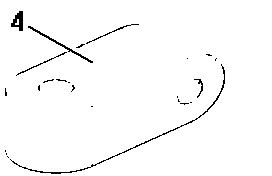Spine simulation structural body for teaching
A structure and simulation technology, applied in the field of medical teaching appliances, can solve the problems of the same internal structure, lifelike, and the vertebrae cannot reach the external shape, etc., to avoid boredom and bottomless, and shorten the distance.
- Summary
- Abstract
- Description
- Claims
- Application Information
AI Technical Summary
Problems solved by technology
Method used
Image
Examples
Embodiment Construction
[0014] As shown in the accompanying drawings, a spine simulation structure for teaching contains 5 lumbar vertebrae 1 and the connecting structure between the joints, and is characterized in that: the connecting structure between the adjacent joints of the lumbar vertebrae is a universal joint, which is There are connecting grooves on the opposite surfaces of the adjacent joints of the lumbar vertebrae and connecting rods 4 hinged to the connecting grooves. The hinge axes at both ends of the connecting rods are perpendicular to each other, and the end faces of the connecting rods are circular arcs with the hinge axes at their respective ends as the axes. surface, and the bottom of the groove is the corresponding arc surface. There is a horizontal rectangular groove 6 on the upper middle of the adjacent joints of the lumbar vertebrae, and a longitudinal rectangular groove 5 on the lower middle. The bottom of the rectangular groove is a semicircular surface, and the upper semicir...
PUM
 Login to View More
Login to View More Abstract
Description
Claims
Application Information
 Login to View More
Login to View More - R&D
- Intellectual Property
- Life Sciences
- Materials
- Tech Scout
- Unparalleled Data Quality
- Higher Quality Content
- 60% Fewer Hallucinations
Browse by: Latest US Patents, China's latest patents, Technical Efficacy Thesaurus, Application Domain, Technology Topic, Popular Technical Reports.
© 2025 PatSnap. All rights reserved.Legal|Privacy policy|Modern Slavery Act Transparency Statement|Sitemap|About US| Contact US: help@patsnap.com



